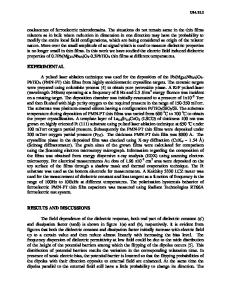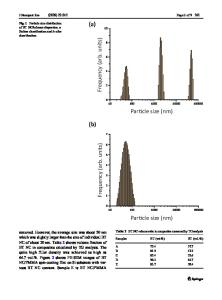Enhanced dielectric properties of polyvinylidene fluoride-based composite films with layered perovskite KCa 2 Na 3 Nb 6
- PDF / 1,196,938 Bytes
- 8 Pages / 595.276 x 790.866 pts Page_size
- 74 Downloads / 371 Views
Enhanced dielectric properties of polyvinylidene fluoride-based composite films with layered perovskite KCa2Na3Nb6O19-derived fillers Yumi Inagaki1,*, Takahiro Kozawa1, Kazuhisa Yano1, and Tadashi Nakamura1
1
Toyota Central R&D Laboratories, Inc., Nagakute, Aichi 480-1192, Japan
Received: 10 June 2020
ABSTRACT
Accepted: 17 August 2020
A polyvinylidene fluoride (PVDF)-based composite film embedded with platelike fillers was investigated as a novel dielectric composite material that can serve as a candidate film capacitor. Plate-like particles of the dielectric Ca2Na3Nb6O19 (CNN6) filler material were prepared through liquid-phase exfoliation of KCa2Na3Nb6O19 synthesized by a conventional solid-state reaction method. CNN6 fillers with an average aspect ratio of 2.0 were successfully dispersed in a PVDF matrix without large aggregation using a solution blending and casting method. The resultant CNN6/PVDF composite film exhibited higher breakdown strength than a dielectric PVDF-based composite embedded with spherical BaTiO3 fillers. The superiority of the plate-like filler particles over spherical filler particles was qualitatively confirmed by finite element simulation using a simplified filler/matrix model. A CNN6/PVDF composite film with a thickness of 3.8 lm exhibited a high capacitance density of 10.1 F m-3, which was three times higher than that of a biaxially oriented polypropylene film currently used for film capacitors in the power control units of hybrid vehicles.
Ó
Springer Science+Business
Media, LLC, part of Springer Nature 2020
Introduction Film capacitors are installed in the inverter systems of power control units (PCU) in hybrid and electric vehicles, and act as smoothing capacitors or filter capacitors. However, the volume of the film capacitors accounts for 25% of the PCU; therefore, improved performance of these film capacitors is Handling Editor: David Cann.
Address correspondence to E-mail: [email protected]
https://doi.org/10.1007/s10853-020-05169-2
required to reduce the PCU volume [1–3]. The performance of a capacitor is generally expressed as: U ¼ 1=2e0 er E2b ;
ð1Þ
where U is the energy density, e0 is the vacuum dielectric constant, er is the relative dielectric constant of the dielectric material, and Eb is the breakdown strength (BDS). To enhance the energy density, the film capacitor material must have both a high relative
J Mater Sci
dielectric constant and a high BDS. Furthermore, the capacitance density expressed by the following equation is also important for downsizing: C ¼ e0 er =d2 ;
ð2Þ
where C is the capacitance density and d is the film thickness of the dielectric material. Therefore, thinner films should be fabricated to achieve high capacitance density. U and C are quadratically dependent on the BDS and the film thickness, respectively; therefore, these properties are especially important. Biaxially orientated polypropylene (BOPP) is commonly used for film capacitors, of which the relative dielectric constant and BDS are 2.2 and 650 V lm-1, respec
Data Loading...











